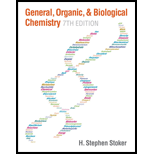
Concept explainers
Interpretation:
Among the given elements, the one that is not present in the
Concept Introduction:
Organic compounds are the important basis of life. They include gasoline, coal, dyes, and clothing fibers etc. The compounds that are obtained from living organisms are termed as organic compounds and those obtained from the earth are known as inorganic compounds. Organic compounds are found in earth also apart from living organisms. All the organic compounds contain the element carbon. Urea was synthesized in the laboratory which is an organic compound.
Functional group in an organic molecule is the feature that is directly involved in most of the
Want to see the full answer?
Check out a sample textbook solution
Chapter 17 Solutions
GENERAL,ORGANIC,+BIO.CHEM.-MINDTAP
- What is the conjugate base of the weak acid, CH3COOH if it reacts with H2O in an acid-base reaction? A. H3O* B. CH3COO С. ОН- D. H2O E. CH3COOarrow_forwardThe analgesic phenacetin is synthesized by treating 4- ethoxyaniline with acetic anhydride. a. Which of the following is the structure of 4- ethoxyaniline? OCH₂CH3 NH₂ OCH₂CH3 NH₂ OCH₂CH3arrow_forward17. 1- Butanol was converted into butyl propanoate by reaction with an excess of propanoic acid. What is the name of this reaction? A. Acid-base reaction B. Base hydrolysis C. Acid hydrolysis D. Esterificationarrow_forward
- A (-) charge in the transition state can be stabilized by a catalyst, which is usually a(n): a. Anion b. Base Oc. Nucleophile Od. Acidarrow_forwardDefine the following terms: a. reducing sugar b. alditol c. enediol d. acetal e. ketalarrow_forwardWhat are the functional groups that can be found in the molecule? A. Ether, secondary amine, alkene (Ether, amina sekundar, alkena) B. Ether, primary amine, alkene (Eter, amina utama, alkena) C. Ether, amide, alkene (Eter, amida, alkena) D. Ester, primary amine, alkene (Ester, amina utama, alkena)arrow_forward
- Indicate whether each of the following descriptions concerning the molecule sphingosine is true or false. a. Carbons 1, 2, and 3 all bear the same kind of functional group. b. Three different kinds of functional groups are present. c. It is an unsaturated diaminoalcohol. d. The carbon chain contains 20 carbon atoms.arrow_forwardWhat type of linkage is catalyzed by peptidyl transferase activity? a. anhydride b. mixed anhydride c. amide d. esterarrow_forwardWhich of the following is not a nitrogenous base? Group of answer choices A. guanine B. uracil C. deoxyribose D. cytosine E. thyminearrow_forward
- What is the isoelectric point of casein? Please choose one correct answer only. A. pH 6.6 B. pH 5.6 C. pH 4.6 D. pH 3.6 E. None of the given optionsarrow_forwardIdentify ALL the CORRECT statements regarding the compound shown below. SELECT ALL THAT APPLY A. The compound is a heterocycle B. The compound is found in DNA C. The compound is a pentose sugar D. The compound is a purinearrow_forwardWhich of the following sugars do not have asymmetric centers? A. Fructose B. Glyceraldehyde C. Sedoheptulose D. Dihydroxyacetone E. Glucuronic acidarrow_forward
 Human Anatomy & Physiology (11th Edition)BiologyISBN:9780134580999Author:Elaine N. Marieb, Katja N. HoehnPublisher:PEARSON
Human Anatomy & Physiology (11th Edition)BiologyISBN:9780134580999Author:Elaine N. Marieb, Katja N. HoehnPublisher:PEARSON Biology 2eBiologyISBN:9781947172517Author:Matthew Douglas, Jung Choi, Mary Ann ClarkPublisher:OpenStax
Biology 2eBiologyISBN:9781947172517Author:Matthew Douglas, Jung Choi, Mary Ann ClarkPublisher:OpenStax Anatomy & PhysiologyBiologyISBN:9781259398629Author:McKinley, Michael P., O'loughlin, Valerie Dean, Bidle, Theresa StouterPublisher:Mcgraw Hill Education,
Anatomy & PhysiologyBiologyISBN:9781259398629Author:McKinley, Michael P., O'loughlin, Valerie Dean, Bidle, Theresa StouterPublisher:Mcgraw Hill Education, Molecular Biology of the Cell (Sixth Edition)BiologyISBN:9780815344322Author:Bruce Alberts, Alexander D. Johnson, Julian Lewis, David Morgan, Martin Raff, Keith Roberts, Peter WalterPublisher:W. W. Norton & Company
Molecular Biology of the Cell (Sixth Edition)BiologyISBN:9780815344322Author:Bruce Alberts, Alexander D. Johnson, Julian Lewis, David Morgan, Martin Raff, Keith Roberts, Peter WalterPublisher:W. W. Norton & Company Laboratory Manual For Human Anatomy & PhysiologyBiologyISBN:9781260159363Author:Martin, Terry R., Prentice-craver, CynthiaPublisher:McGraw-Hill Publishing Co.
Laboratory Manual For Human Anatomy & PhysiologyBiologyISBN:9781260159363Author:Martin, Terry R., Prentice-craver, CynthiaPublisher:McGraw-Hill Publishing Co. Inquiry Into Life (16th Edition)BiologyISBN:9781260231700Author:Sylvia S. Mader, Michael WindelspechtPublisher:McGraw Hill Education
Inquiry Into Life (16th Edition)BiologyISBN:9781260231700Author:Sylvia S. Mader, Michael WindelspechtPublisher:McGraw Hill Education





